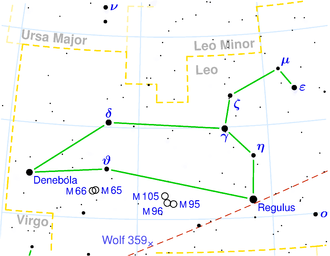NGC 3819
| Galaxy NGC 3819 |
|
|---|---|
![NGC 3819 with 2MASX J11420497 + 1021267 [1] (above), SDSS image](https://upload.wikimedia.org/wikipedia/commons/thumb/5/5f/NGC3819_-_SDSS_DR14.jpg/300px-NGC3819_-_SDSS_DR14.jpg)
|
|
| NGC 3819 with 2MASX J11420497 + 1021267 (above), SDSS image | |
| AladinLite | |
| Constellation | lion |
|
Position equinox : J2000.0 , epoch : J2000.0 |
|
| Right ascension | 11 h 42 m 05.8 s |
| declination | + 10 ° 21 ′ 04 ″ |
| Appearance | |
| Morphological type | E1 |
| Brightness (visual) | 14.0 mag |
| Brightness (B-band) | 15.0 mag |
| Angular expansion | 0.8 ′ × 0.7 ′ |
| Position angle | 136 ° |
| Surface brightness | 13.4 mag / arcmin² |
| Physical data | |
| Affiliation | WBL 350-002 HCG 58 |
| Redshift | 0.020928 ± 0.000037 |
| Radial velocity | 6274 ± 11 km / s |
|
Stroke distance v rad / H 0 |
(277 ± 19) x 10 6 ly (84.8 ± 5.9) Mpc |
| history | |
| discovery | John Herschel |
| Discovery date | January 18, 1828 |
| Catalog names | |
| NGC 3819 • PGC 36311 • CGCG 068-030 • MCG + 02-30-013 • 2MASX J11420585 + 1021047 • HCG 58D • GC 2505 • h 950 • GALEX ASC J114205.80 + 102103.2 • LDCE 835 NED003 | |
NGC 3819 is an elliptical galaxy from the Hubble type E1 in Leo on the ecliptic . It is estimated to be 277 million light years away from the Milky Way and has a diameter of around 65,000 ly.
In the same area of the sky are the galaxies NGC 3817 , NGC 3820 , NGC 3822 , NGC 3825 , among others .
The object was discovered on January 18, 1828 by John Herschel .
